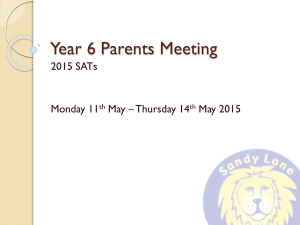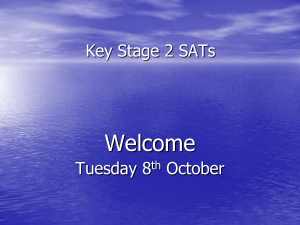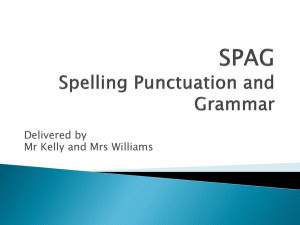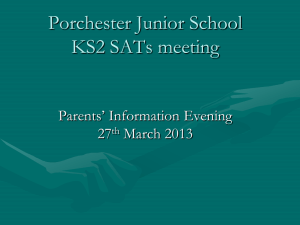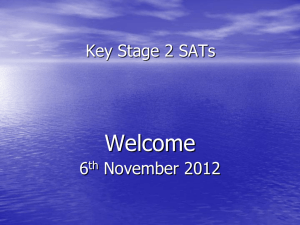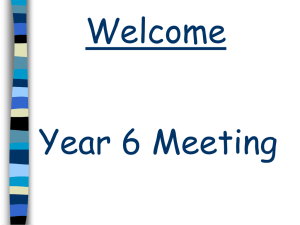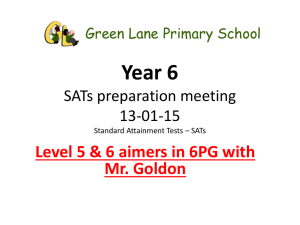Information for Parents on Key Stage 2 SATs
advertisement
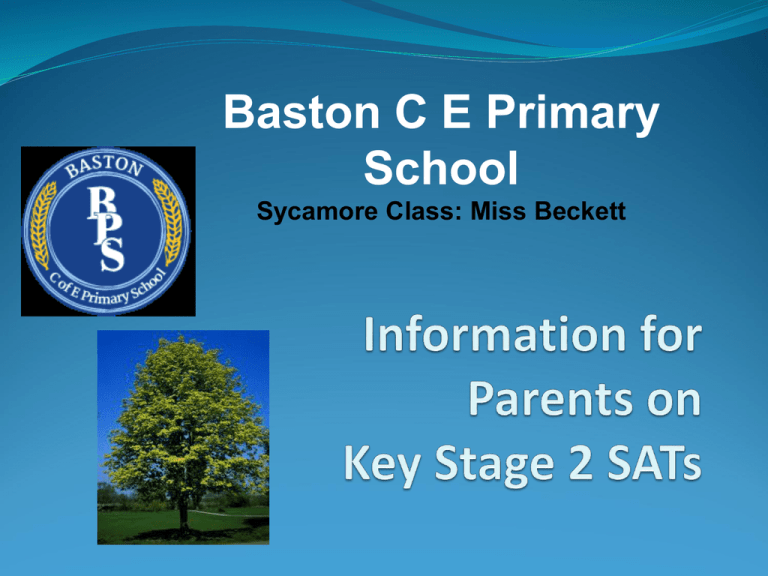
Baston C E Primary School Sycamore Class: Miss Beckett What does SATs stand for? Statutory Assessment Tasks and Tests (also includes Teacher Assessment) At the end of Key Stage 1 (at age 7) and at the end of Key Stage 2 (at age 11) What level should children be at? A typical 11 year old is expected to be a Level 4 by the end of Key Stage 2. Some children will still be at Level 3 and some children will achieve Level 5 or above. Level 5 is a typical 13 year old and level 6 is a typical 14 year old. A small percentage of children will not yet be working at Level 3. How are the children assessed? For children working at Level 3 and above, there are two sorts of assessments: A) Teacher assessments B) Tests For children working below Level 3, the only statutory assessment is teacher assessment and those children do not take the tests. What does teacher assessment involve and is it different from testing? Teacher assessment draws together everything the teacher or teachers know about a child, including normal class lessons, observations, marked work and school assessments. Teacher assessment is not a ‘snapshot’ like tests and is therefore more reliable. Due to the above, there can be a difference between teacher assessment results and test levels. Teacher assessment only, is used for children who work below level 3. Teacher Assessments: English: Speaking and Listening Reading Writing Maths: Using and Applying Number and Algebra Shape, Space and Measures Handling Data Teacher Assessments: (cont.) Science: Scientific Enquiry Life Processes Materials and their Properties Physical Processes When do KS2 tests happen? This year the test dates will be from Monday 12th - 16th May 2014 Please avoid taking your child out of school during this time and in the weeks leading up to the tests. This will be a busy week! ENGLISH Reading Comprehension This year the texts in the levels 3-5 English reading booklet will not be linked by a theme. The booklet will contain three or four different texts. The least demanding text will come first with the following texts increasing in level of difficulty Instead of being given 15 minutes reading time and 45 minutes to answer the questions, children will have a total of one hour to read the texts and complete the questions at their own pace. The reading answer booklet will comprise of approximately 35 to 40 questions (totalling 50 marks). The questions are: shorter, closed response items (such as multiple choice and matching questions) shorter, open response items longer, open response items that require children to explain and comment on the texts in order to demonstrate a full understanding. Questions are worth 1, 2 or 3 marks. English grammar, punctuation and spelling A new statutory test of English grammar, punctuation and spelling was introduced for children at the end of Key Stage 2 from May 2013. The level 3-5 test will assess children’s abilities in the following technical aspects of English: grammar; punctuation; spelling; vocabulary. Examples: Circle all the adverbs in the sentence below. Open the drawers carefully and quietly when using the filing cabinet. Add a suffix to this word to make an adjective. dread ______________ Underline the subordinate clause in each sentence below. One has been done for you. Although his Mum thought they were very smart, Peter disliked his new trousers. Before he could go swimming, Ali packed his towel. Complete the sentence below with a contraction that makes sense. If you give me the recipe____________ buy the ingredients on the way home. MATHS This year, the levels 3-5 mathematics test consists of: two non-calculator test papers, Paper 1 and Paper 2, each lasting 45 minutes mental mathematics test, lasting 20 minutes Children’s marks from all three tests are aggregated to calculate their overall mathematics score/level. Level 6 children will still have a calculator paper following the previous years’ format. Teachers may read questions in both written papers to pupils if asked. Example questions for level 3-5. Level 3-5 continued. Level 3-5 continued. Example question for level 6 Calculator paper – level 6 SCIENCE •Science sampling tests for children at the end of Key Stage 2 recommence in June this year, on a biennial basis. •Only 5 children randomly selected from 1900 schools in England to take 3 science papers (25mins. each) How is SATs week organised? A timetable is issued to school, telling us on which days tests must be administered. We can determine at what time tests begin. All children must sit the tests at the same time. Tests are completed in classrooms, with any displays that may help covered over. The LA monitor 10% of schools per year. Children are divided into groups for test administration to ensure they are properly supported and feel secure. What help can children have? In the reading test, children must read the text and questions by themselves, but may have help recording their answers, if this is done in a normal classroom situation. In maths, papers 1 and 2, teachers can read questions to any child who asks. Also in the SPAG test, children can ask for questions read to them but nothing can be explained. How can parents help? The best help is by taking an interest in your child’s learning and progress. Giving positive encouragement. Attending meetings and parents evenings. Supporting regular and thorough home learning. Fun websites: MyMaths/BBC Bitesize. Not putting children under too much pressure. Ensuring children arrive for tests: in good time - with equipment – pen, water bottle, snack, etc., having had breakfast having gone to bed at a reasonable time! 2012013 Test Timetable3 Test 2014 Test Timetable 12th May 13th May Reading Test English grammar, Mental Maths punctuation and Test spelling test 20 minutes 1 hour to read and answer at own pace 14th May 45 mins./15mins. 15th May Maths Test B No calculator 45 minutes Maths Test A No calculator 45 minutes Level 6 Reading (10mins. reading time+ 50 mins. to answer) Level 6 SPAG (1 hour inc. 30 mins. Extended writing task) Level 6 Maths papers 1 & 2 30 minutes each (Calculator allowed in paper 2) 16th May Reporting Levels Reading, SPAG and maths tests are all externally marked. Test results are returned to the school in July and will be reported, along with teacher assessments, to parents by the end of the year. Secondary schools also use this data to support their transition programmes for moving in to Year 7. Hopefully this has been helpful and not daunting! Thanks for coming along this evening!


